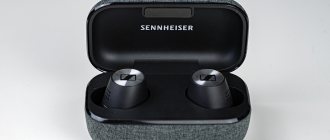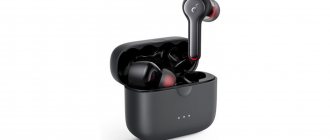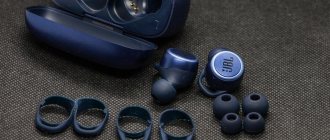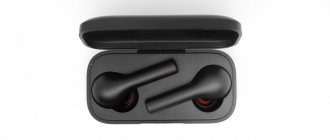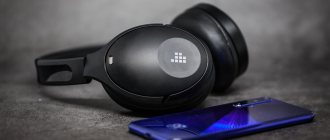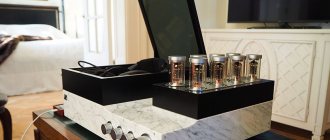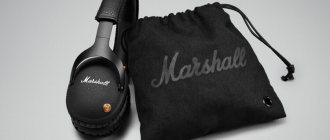Home News and reviews Product measurement reports Comparison and selection About RAA Settings Ru>>En
News and Reviews Product Measurement Reports Comparisons and Selection About RAA
The site engine is being updated, some of the functionality is temporarily not working
FAQ / Headphones / On-line test for defects in headphones
This page is made for a quick check of headphones. If the track names are unclear and it is unclear what they are checking, then read the detailed material on how to check headphones for defects.
Pink Floyd Essentials
One of the best British rock bands of the last century, famous for their psychedelic music, acoustic experiments and amazing guitar solos. In the playlist you can find things from the legendary album The Wall, the brilliant “Shine On You Crazy Diamond”, as well as “Breathe” from one of the best-selling albums in the world, The Dark Side of the Moon.
The music of “kicks” enchants and bewitches . It's ideal for listening while driving at night on an empty country highway. Well, or at home, when no one and nothing distracts you.
Only good “home” headphones will allow you to appreciate all the small nuances of sound. For example, Philips Fidelio X2 will allow you to hear the full depth and richness of the sound of music and provide the most detailed compositions. This is achieved thanks to the open type design, which ensures the movement of the diaphragm. You won't get this with simple plugs.
Marking
The headphones are marked with letters and colors. These are English capital letters L and R. Colors: right - red, left - blue or green.
R - Right - right ear. Red.
L - Left is the left ear. Blue or green.
Attention! If the letters are not striking, then the headphones need to be examined from all sides. Different brands place the markings in different places, sometimes inside.
Hans Zimmer Essentials
If you are a film buff, then the name Hans Zimmer is not an empty phrase for you. The German film composer wrote music for such hits as “The Dark Knight”, “Interstellar”, “Pirates of the Caribbean”, “Inception”, “Rain Man”, “Gladiator”. Many iconic things can be found in the presented playlist.
The main thing is that the headphones can handle the bass, Hans loves that. Can your headphones handle “No Time For Caution” well? Or does organ music turn into a mess of sounds? Let's check.
Checking headphones online - left-right test (Video)
Sound test suitable for speakers and any stereo device
If you need to do a headphone test, the easiest way is to find a suitable track or video online. Most often, checking headphones is required when there are doubts about whether both emitters play equally loudly. We found the most suitable video for testing left-right headphones: short, to the point, nothing superfluous.
This online test is suitable for testing any headphones and headsets, be they full-size, in-ear or any other. Suitable for speakers too. After this test online, you can move on to checking the sound, but it’s better to check the quality offline. Read more about this below.
- TOP 15: Best headphones for music
- TOP 10: Best headphones for music by genre
Record voice through a microphone online.
With " Online Microphone " you can record your voice, song or any other sound through a regular household microphone. And all this can be done on this site online directly through your browser. However, the quality of the recording will largely depend on the features of your microphone. If it is old or very simple, then there will likely be various artifacts when listening, such as crackling, rustling, extraneous noise, and so on. If you require perfect sound without interference or other distortions, we recommend using our service in conjunction with a condenser microphone connected to a preamplifier. In this case, the recording will not only be of the highest quality, but also with pleasant “tube” effects.
Also, with the “ Online Microphone ”, you can record the sounds of any musical instruments. For example, guitar, piano, violin, drums and much more. But in order for such a dictaphone recording to be of lesser quality, it must be made in absolute silence and in a room without reverberation (that is, without echo, because otherwise the sound waves will be reflected and returned to the microphone, causing interference). The ideal room for such recording would be a small room filled with furniture and plastic windows. Close the door, remove all extraneous sounds and write your masterpieces using the free “Online Microphone”!
Connection to PC/laptop
The first thing to start with is properly connecting the headphones to the computer. First, you must have a sound card installed (all home PCs usually have one).
Do you have a sound card on your computer and what model is it:
Secondly, the headphones have only 1-2 plugs (and, it would seem, what should you connect here? ☺) - there are a couple more nuances here (many users don’t even pay attention to this!). Nowadays on home computers/laptops, in addition to the classic jacks (for microphone and headphones), there is a headset jack (see Fig. 1)! Near the headset jack, there is usually a small icon of headphones with a microphone.
Rice. 1. Classic (left) and headset (right) jack(s)
The point here is that you cannot connect regular headphones (with two plugs) to the headset jack, just like headset headphones cannot be connected to classic audio jacks. For proper connection it is necessary to use special adapters.
Rice. 2. Adapter for connecting classic headphones with a microphone to the headset jack
Note!
If you don’t know what kind of headphones you have, then pay attention to the number of contacts on the plug: if there are 4 of them, these are headset headphones, if 3 are classic ones (an example is shown in Fig. 3 below).
Rice. 3. Headset (left) plug and classic (right)
More information on this topic is covered in this article:
I will assume that the headphones and microphone were connected correctly, the wires are fine and the connectors are fine too. By the way, it would be a good idea to test your microphone on another PC (to be sure that the microphone is working at all...).
Sound devices in Windows
In Windows 7,8 and 10, the sound system is designed so that the sound is output to the current “default device”. Let’s open the sound control panel, to do this, right-click on the speaker icon near the clock and select “Sounds” and go to the “Playback” tab:
The screenshot indicates that the audio will be output to “Speakers – High Definition Audio Device” because it is selected as the “Default Device”. There is also a “Default communication device”, it is used in instant messengers such as Skype, Viber, WhatsApp:
When you've connected your headphones, a new device may appear here, and if it's not marked as "default" then right-click on it and select "Set as default":
Usually there is only one device in the list, but if you have a TV or monitor connected via HDMI, you will see it in the list of Windows audio devices. You can easily understand which device you connected the headphones to, to do this, right-click on each device in turn and select “Check”. A test tone should sound in the headphones. Microphone recording is configured in the same way.
On some Realtek sound cards, you can separate the rear and front sockets of the computer, i.e., so that the rear and front sockets appear as one common one, or as two separate devices. To do this, go to “Control Panel -> Hardware and Sound” and look for “Realtek HD Manager” there:
In the upper right corner, click on “Advanced device settings”:
You can choose from two modes: classic and multi-threaded. In multi-stream mode, the rear and front outputs operate separately, i.e. You can set different sound output to speakers connected at the rear and headphones connected at the front. In classic mode, these jacks are set to the same sound flow. Also, in the Realtek Manager, reassignment of sockets is available, so you can assign not a green socket for headphones, but, for example, a black socket.
Setting the sound in headphones
If there is still no sound, then read the article about solving sound problems. When sound appears in the headphones, you can adjust the sound parameters; to do this, go to the sound control panel to the “Playback” tab and double-click on the device.
Volume and balance
Let's go to the "Levels" tab:
The slider sets the overall volume level, but it is also available by clicking on the speaker icon next to the clock. But the balance of the left and right channels is available only from this window. Press the "Balance" button and adjust the level of the right and left channels, if necessary. When you change the master volume, the levels of the right and left channels will change in proportion to the values you set.
Enhancements (Sound Effects)
On the “Enhancements” tab, you can configure sound effects; they are also called improving sound quality. The list of effects differs depending on the sound card and drivers, but the logic of application is the same. The “Disable all enhancements” checkbox disables all sound enhancements, so for the effects to work in headphones, you need to uncheck the box:
Next, mark the desired effect and click the “Settings” button. Each effect will have its own settings. Here is a list of some "improvers":
- Bass Boost: Increases the level of low frequencies. In the settings you need to select the frequency (Frequency) and gain level (Boost Level). For headphones, suitable frequency values are 50-100 Hz, gain 3-12 dB, selected individually by ear;
- Virtual Surround: encodes multi-channel audio as stereo (for receivers);
- Room Correction: allows you to adjust the sound using a calibrated microphone to compensate for the reflectivity of the room, not relevant when connecting headphones;
- Loudness Equalization: equalizes loud and quiet sounds, can be useful for listening to quiet recordings through headphones;
- Equalizer: an equalizer for adjusting the sound timbre, less common.
The “Preview” button will help you evaluate the impact of the effect on sound quality. It plays a test sound, or your audio file.
Sampling frequency
You don't need to change anything in the Advanced tab, but if you are listening to high-quality soundtracks with a sampling rate higher than 48 KHz, i.e. It makes sense to choose from the list “24 bit, 96000 Hz” or “24 bit, 192000 Hz (Studio recording)”. In the normal case, there is no difference in sound quality, but the load on the processor increases. The default should be "16bit, 48000Hz (DVD Disc)".
We don’t touch the “Exclusive Mode” block, but if there is no sound in your program after some other program is launched, then uncheck both boxes.
Soldering on
Where and who should be soldered? Everything is very simple. A speaker coil is simply a piece of wire twisted and glued together. As such, the coil itself does not have a concept of plus and minus. Usually the beginning of the coil is taken as a plus, and its end as a minus.
But don't bother. Polarity is easily determined after soldering. It is better to solder so that both wires can reach freely.
Each speaker has a contact group. Most often this is a piece of fiberglass with four contacts. In this case, the left two are closed to each other, and the right two are closed to each other. The coil wires are soldered to the top two contacts, and the wires coming from the plug to the bottom two (yellow and blue). Thus the circuit is closed.
We sorted out the contacts. It's time to try on a new diffuser. To do this, we just need to solder the coil wires to the top two contacts. If one or the wires do not reach the contacts, then solder an additional piece of wire to the pads. And now we solder the coil wires to the wire
AirPods Studio price
How much will Apple ask for such miracle headphones? AirPods Pro sell for $249, and Beats Solo Pro, which could be the basis for Apple's first over-ear headphones, sell for $299. In theory, Apple's over-ear headphones will cost even more, perhaps $349 or $399. That is, about 30,000 rubles. A survey among readers in our Telegram chat and on the website showed that no more than 10% are willing to pay this amount for full-size AirPods. Almost a fifth will pay a maximum of 15,000 rubles.
Readers of AppleInsider.ru are not really looking forward to full-size Apple headphones
However, almost half (44% of readers) are not thinking about buying such headphones at all. Not surprising, because making a decision based on rumors is very difficult.
Now the sound of AirPods can hardly be called a reference. However, all this fades into the background given the ease of use that the AirPods Pro give me. The headphones have excellent integration with iOS, work great in talk mode, and the charging method is simply brilliant - thanks to the case, the headphones are always 100% charged. In addition, AirPods are very comfortable - you can wear them for a long time without any problems. Well, noise reduction and “transparency” are a must-have for any headphones that are currently on the market.
If Apple brings this experience to over-ear headphones, it will definitely be a win. And I have no doubt that the company will be able to make the sound really good - this has already been proven with the HomePod smart speaker.
Measurements
The tested unit was pre-production, so we will keep in mind that the manufacturer may make changes to the design and firmware that will affect the results of hardware tests. At the same time, the current results as such turned out to be quite worthy.
The average line of the frequency response has a moderate slope in the bass and lower mids, and tends to be linear in the upper mids. Unlike passive planar magnetic models, the Audeze Mobius does not have deep dips in the lower HF range.
Distortions fall within the range of 0.1-0.5%, which is a good indicator. The local rise in the region of 400-2500 Hz surprisingly coincides with a flat part of the frequency response and, most likely, this region is subject to software equalization. At the same time, it is worth noting that the phase measurement results of this model are surprisingly good, which also speaks about sound processing and de facto has a positive effect on the sound.
Method 2: Media Player Classic Home Cinema (MPC-HC)
A slightly more specialized method, which is suitable for fans of watching movies and TV series, is to use an application for playing videos with the ability to change channels. One of these is Media Player Classic Home Cinema.
- After downloading and installing, launch the video player and use the “File” - “Quickly open file” items.
Using Explorer, select a video file with a stereo audio track and open it.
- Pause playback with the Spacebar, then use “View” - “Settings”.
- Here, open the “Built-in filters” section and go to the “Audio Switch” block. Activate the “Enable built-in audio switcher” option, then “Enable custom channel allocation”.
When the “Setting columns for” menu becomes active, select “2” in it, then in the table below mark the positions as in the screenshot below. To apply the settings, click “Apply” and “OK”, then restart the player.
Now, when playing video files with stereo sound, the channels will be swapped.
How to determine if there are no inscriptions
If there are no letters, you can determine which earphone is right and which is left in several ways.
Experienced way
- You need to touch the surface. The outer side of the left earpiece contains several raised plastic dots. On the right - they are absent.
- According to the length of the cord. A longer wire is connected to the left earphone.
- According to the presence of a microphone. If you put on the headset correctly, the microphone will be in front, if not, it will be at the back.
- The feeling of comfort. The headphones look the same only upon visual inspection. In fact, they are asymmetrical and slightly curved in different directions. If worn incorrectly, the headphones will cause discomfort.
- By sound. When you turn on the sound and suddenly turn off the power, the sound will disappear first in the right ear, and then in the left. When you turn on rock, the bass sound will be heard from the left. If the sound sounds strange, it is clear that the headset is not worn correctly.
- Check the wire connections. If the connectors are the same, users may confuse the cables. An earphone with a wire is marked with one color: red - right “ear”, green (blue) - left “ear”. If there are no tags, the problem is solved by switching the wires.
Via the Internet
- Watch the video. You need to find any video portal and enter “Find right and left headphones” in the search bar. The video will show the inscriptions and differences between the right and left “ears”. If they match the user ones, then everything is done correctly; if not, then the contacts are soldered incorrectly. Needs to be re-soldered.
- Conduct an online audio test to check right-left.
- Install the RealSpace3DAudioDemo application in order to, in addition to performing a channel test, position the sound in a surround format.
- The Skype program will easily check the channels for correct connection.
- You can also check whether the channels are connected correctly using a PC. To do this, by pressing the manipulator key on the right, the volume icon is highlighted and the playback devices item is selected in the menu that appears. In the list that appears, select a green device. In the window that appears, the speakers tab opens and the stereo mode option is enabled. After this, you can start checking channels.
- Use the WinMap music player. Launch the application and try to switch channels using the slider. When it is moved left-right, the direction of the sound changes. If it comes from the other side, then the channels are soldered incorrectly.
Method 3: Using Cables
The last, most reliable option in terms of efficiency is to hardware-replace the channels. For this we will need adapter cables - for example, from a 3.5mm connector to a two-channel RCA-male, and an RCA-female to an audio jack.
The next steps are quite simple: connect the first cable that goes to RCA to the headphones. Then connect the RCA outputs to similar connectors on the second wire - the white output to the red port and vice versa - after which connect this entire structure to the computer and check the sound, the channels should now match each other or, conversely, be swapped, if this is the case your aim.
This method is more complicated than the previous ones, and involves material expenses, but practically guarantees a positive result.
Source
Test using the Sound Recorder app
Click the “Start” button, go to the “Programs” section and in the “Standard” directory, find “Sound Recorder” (in “Seven”) or Voice Recorder (in “Ten”). Record a few phrases and save the audio file. When listening, in addition to the functionality of the microphone on the headset, you can check whether it is noisy or emitting extraneous sounds.
I don’t recommend using online services to test hardware - nowadays it’s a big imprudence to trust too much to sites found through a search engine, and then give them access to the computer’s hardware. However, the standard Windows tools described above are quite sufficient for the test.
Subscribe to me on social networks to receive timely notifications of new publications. See you soon!
Sincerely, blog author Andrey Andreev.
